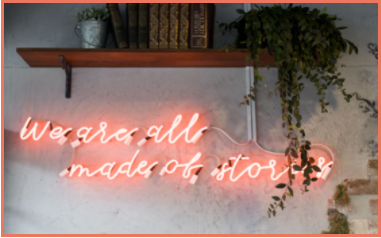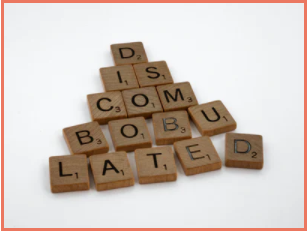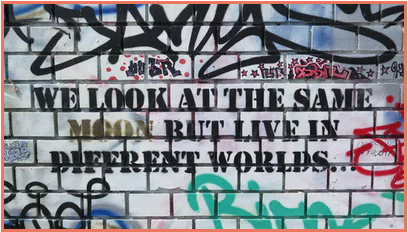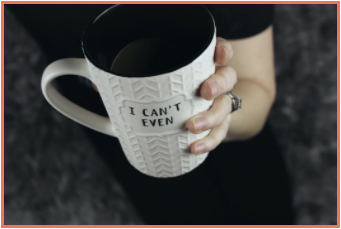Diversity, Equality/Equity and Inclusion, meet Eye Contact in Communication
May 26, 2021A Story

Here’s how I imagine it: a cocktail party filled with all of the elements of communication - there’s Emphasis over there in the sari, Posture in her tea-length dress is over by the bar, Volume is in a hijab and telling a story to a group of rapt listeners - everyone’s here. Or are they?
Just then, Diversity, Equality/Equity and Inclusion (who goes by “DEI”) comes in from the snowstorm raging outside. She shakes off her parka and fluffs her hair, a cascade of fluffy snow crystals jettisoned into the air around her.
Hanging her coat, she comes down the stairs into the party area. Several friends go over to welcome her, and she smiles and hugs them all happily (this is a party where COVID hasn’t been invited).
Suddenly, Eye Contact appears at the group’s periphery. He’s dressed sharply and Confidence stands by his side, looking dapper in a three-piece. He thrusts his hand forward, simultaneously saying to DEI, “I don’t think we’ve met...”.
His look of expectation falters when he starts to realize that DEI is neither looking at him nor taking his proffered hand. The group titters awkwardly, and finally Confidence pipes up and says, “It’s lovely to meet you. I’m Confidence.” He doesn’t offer his hand, and he bows slightly towards DEI. She relaxes visibly, and gently answers, “I’m DEI.” The tension in the group dissipates.
What Just Happened??

I tell this allegorical tale to illustrate a few things: first, there are many, MANY diverse elements that can go to a communication party (and not everyone is invited every time).
Second, each of these elements has a personality of their own, and interacts with each other in a variety of ways.
Third - and most important for our purposes today - these component pieces often operate differently when encountering the notions and realities of Diversity, Equality, and Inclusion.
Of course, DEI is the darling of the party right now. That’s not a criticism, by the way. Just a simple statement of fact.
Many years ago, I ended up at a party like this. By that, I mean I learned that when Eye Contact and DEI met, it wasn’t smooth sailing.
Eye Contact, being a regular at the party, thought he knew how to act - after all, what else is there to do when you meet someone but offer your hand and introduce yourself with Confidence.
In all fairness to Eye Contact, the parties - up until tonight’s - had featured a regular cast of characters, and he knew that he, being Eye Contact, was a major celebrity at these events.
Until tonight, that is. All of a sudden, DEI was there, and when he tried to engage with her in his usual manner, it flopped.
Why? Isn’t Eye Contact always appropriate? Well, clearly he wasn’t in this case.
But still: Why?
Oh, You Mean the Way I Do It Isn’t the Way EVERYONE Does It?

Back to my origin party - the party where I learned that Eye Contact isn’t always the tried-and-true guest I've been taught he was.
When I was 24, I was offered a position as an adjunct professor in Communication and Presentation (yeah….I was young). I’d grown up in a family business, so as far as diversity was concerned, I’d experienced about as much as a small-town southern Alberta girl could manage.
From about the age of fourteen, I was on the floor, helping customers. Many of the things I learned about diversity I learned the hard way - like many of us.
So when I started as a prof (I’d actually been teaching for five years at this point - long story) I felt nervous but competent. I was a walking encyclopedia of theory and practice in my field, and I was aware that communication styles were often geographically- and culturally bounded.
For all of this knowledge, I didn’t put two and two together when I was faced with reality. And even when the reality was stark, it STILL took me a while.
My first sections (classes) of Presentation Communication were uniquely diverse: the groups were roughly ⅓ exchange students from a technical institute in Japan, ⅓ Latter-Day Saint (Mormon) returned missionaries (RMs) and farm kids from Saskatchewan, and ⅓ multi-aged participants from the two closest First Nations reservations to the College where I taught - the Blood Tribe (Kainai Nation) and the Peigan (Piikani Nation).
The challenges were manifold.

Now, if I just went into this with a fact-dump, and a rigid structure, then it would have been an adapt-and-survive model (for the students). My plan, however, was an adapt-and-survive model for me. I actually want the people I work with to learn, enjoy, apply, and value our time together.
Bit of a hard sell when you teach the one discipline/skill that most people would ostensibly choose death over doing. So, young prof, dreaded subject, wildly-varied classroom. Yeah.
Many MANY things were learned that first semester, I assure you. But the one that made the most profound impression - and fundamentally changed me as a person, a teacher and a coach - had to do with our friend Eye Contact.
In a Presentation Communication course, you can expect a few things - one major one being you have to present and communicate. Seems straightforward, right?
Wrong.
But I didn’t know I was wrong...yet.
Funny thing about Colleges - most of them expect you to provide grades for students. And they also expect that those grades be based on some sort of metric. When you have something as subjective as my discipline, it gets murky.
So, generally, we resort to observable behaviours, such as length of time, structure and...you guessed it...eye contact. As part of my marking rubric, I’d allocated a decent percentage to that component. It was a long time ago, but if memory serves, it was about 5% of the overall grade.
The process is straightforward: students were given the assignments and the presentation dates; they were taught the content; they worked with the content inside and outside of the classroom in order to develop a deeper understanding and deploy the new skill sets.
On the day of the presentation, they would take the stage, and I would sit at my desk with grading sheets, timers, a slew of pencils, and away we went.
It didn’t take me long to start to see a pattern: my Aboriginal students were scoring between one and zero on eye contact. They knew the concept, they understood the assignment, they’d shown eye contact in classroom interactions, yet almost without fail, they neglected to exhibit the behaviour during the graded presentation.
Being fair-minded, I had no choice but to score them based on my observations. But it bothered me a great deal. I asked around for potential explanations from my colleagues, and no one had anything to offer.
It wasn’t until a mature First Nations student came to my office to ask some questions that I saw the light. Or the light smacked me upside the head. Your pick.
She and I had a good rapport, so I thought, “Well, maybe….” and I asked.
Her answer left me gobsmacked. Simply put, culturally, the students had been taught that you don’t make eye contact in formal situations with someone viewed as an elder, as a sign of respect.
I was, being the teacher, the expert/elder, and their “neglect” around eye contact was actually their way of honouring me.
I felt like the biggest turd ever.
When I brought this up with a colleague and - until then - mentor, her response further floored me: her position was that all students needed to learn to make eye contact, and it wasn’t her problem if they had cultural learning that differed from the prescribed content. “When in Rome...” was more-or-less her stance.
My Stance

I didn’t find it quite so easy to dismiss. Perhaps it was my age; perhaps it was because of my upbringing - I really don’t know. But I was left feeling like I couldn’t just simplify the situation and then expect it to go away.
I was torn: as an instructor, my “job” was to teach students the “right way” to do presentations...right? And that meant indoctrinating them to the Western, English mode...right?
After all, when they went out into the world, that’s how they were going to be judged. By “allowing” them to continue with their culturally-mandated-yet-mistaken avoidance of eye contact would only harm them in the long term….right?
I mean, how often were they going to be in front of audiences that shared my framework and expectations, and wouldn’t those audiences subsequently judge the students’ efficacy and professionalism based on such behavioural markers as eye contact?
Wouldn’t it be disingenuous to pretend anything else was true?
On the flip side, I knew instinctively that forcing one cultural mode of expression upon another (by way of giving/withholding marks and access to future opportunities that result from “good grades”) was inherently wrong. I couldn’t necessarily articulate it - I just sensed it.
Further, with such a diverse group of students, how far could I afford to go down the road of cultural relativism? One set of rubrics for each rough grouping of students? I could see where that would implode quickly.
Frankly, I didn’t know what to do, and no one seemed willing or able to help me. So I did what I have so often done since, when faced with similar situations (and believe me, there have been a LOT): I started a conversation.
At the risk of appearing to be unknowledgeable (anathema to professors, in general, at least back then), I just sat down with the students and told the truth.
I asked questions. I listened to answers. I heard all kinds of things, up to and including that this was the very first time ANY of them had been engaged in such a conversation.
I learned in those few short days that so much of what I “knew” was culturally-bounded. That was the beginning of my journey into cultural competence….and in many ways, it was also my students’.
In the end, we all agreed that we would have the students define their own parameters, and I would mark against those. It was the only thing that seemed to make sense.
It wasn’t perfect, and it didn’t address the biases they would still face in the larger world, but it at least - I hoped - would create awareness about how to start conversations that might lead to change in their futures.
This was a long time ago: I don’t know how the story continued, and I don’t care to speculate. All I know is that this experience was a sea change moment for me.
Returning back to our partygoers, and the awkward exchange between DEI and Eye Contact: it’s going to take a while for them to get to know each other. It won’t, perhaps, be as smooth as either would have hoped. But, like many quality relationships, they will figure it out - and they’ll be better for it.

xo d
Want to join a group of women setting about to own their voices, their lives, their futures? Consider joining TEEwithD’s Private Facebook Group, “Dangerous Prima Donnas” for support, resources, and weekly Lives.


